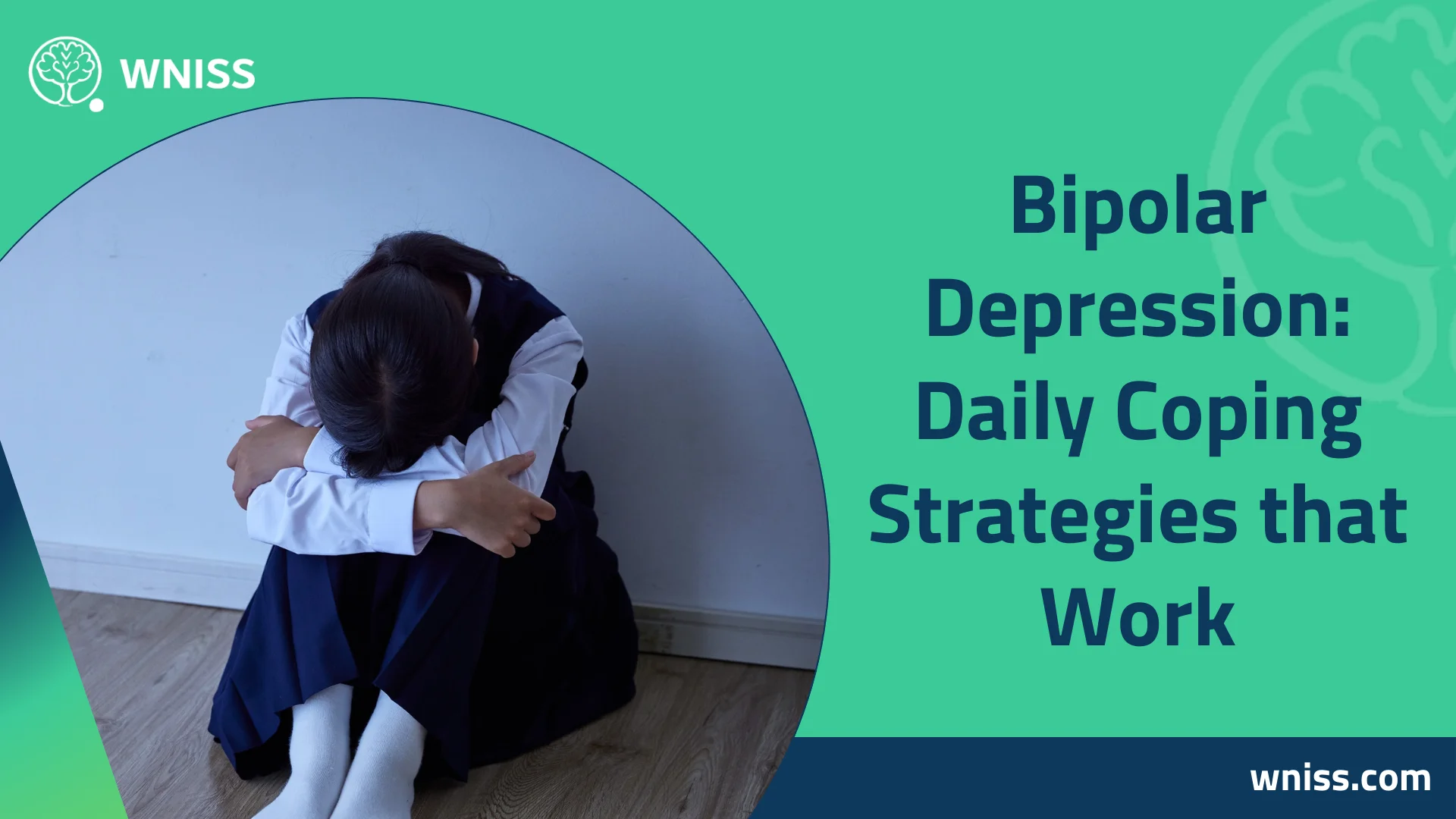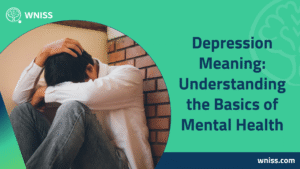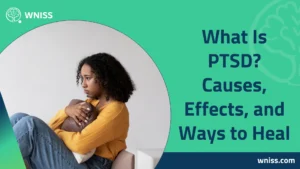When people search for bipolar depression, they’re often looking for more than definitions—they want steps they can use now. Bipolar disorder includes both manic/hypomanic and depressive episodes, but for many, the depression side is the heaviest: fatigue, slowed thinking, and a loss of motivation. Understanding what bipolar depression looks like in daily life, what can trigger it, and which treatments truly help is key to building a routine that lifts mood safely and steadily.
What Is Bipolar Depression?
Depressive episodes in bipolar disorder feel like the energy, attention, and hope “budget” has been cut—sometimes abruptly. Unlike unipolar depression, there’s also a history (or risk) of activation (hypomania/mania), so the care plan must lift mood safely. Think episodes lasting days–weeks, with low mood, low interest, and function loss—often after sleep or stress disruption.
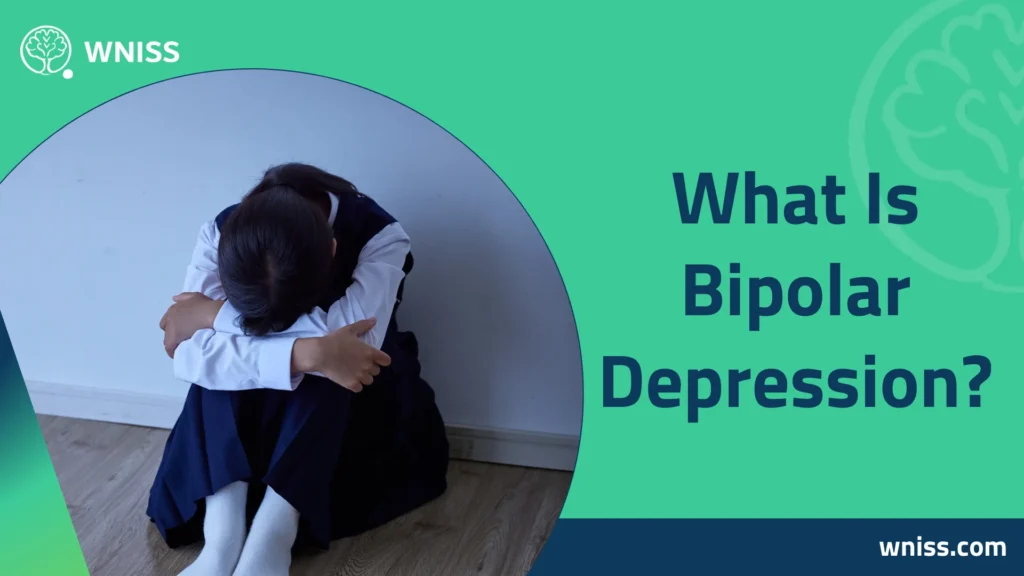
- Persistent low mood or loss of interest in activities you once enjoyed
- Fatigue, slowed thinking/speech, or decision gridlock
- Sleep and appetite shifts (too much/too little)
- Guilt, pessimism, or thoughts of death in severe cases
- A personal or family history suggesting hypomania/mania elsewhere on the timeline
Why Does Bipolar Depression Happen?
There’s no single cause; think biology + circadian rhythm + stress + habits—together they can pull mood down and keep it down. You can’t change genetics, but you can change exposure to triggers and install routines that protect mood.
- Biology & genetics: heightened sensitivity in mood–reward–sleep circuits
- Circadian disruption: irregular bed/wake times, night shifts, jet lag, and low morning light
- Stress load: ongoing pressure reduces sleep depth and resilience
- Substances & meds: alcohol fragments sleep; stimulants and some antidepressants may destabilize mood in susceptible people
- Behavioral patterns: avoidance and inactivity shrink your world and reinforce low mood
How Clinicians Diagnose Bipolar Depression (More than a quiz)
A solid assessment ends with a plan—not just a label. Clinicians map timeline and function, screen for bipolar features, and rule out medical/substance causes that mimic depression
- Structured interview: mood, energy, sleep, speed/spending, family history, and safety
- Validated tools: brief rating scales to track change (they don’t replace judgment)
- Rule-outs: thyroid disease, sleep apnea, substances, ADHD/trauma
- Specifiers: mixed features or psychotic features change medication strategy and urgency
What Treatment Actually Works (and stays safe for bipolar)
Successful care integrates medication + psychotherapy + rhythm protection, measured weekly so progress is visible. For bipolar depression, medications are chosen with activation safety in mind; therapy restarts momentum; routines protect sleep and circadian timing.
Medication (foundation):
- Mood stabilizers and/or atypical antipsychotics tailored to phase; if an antidepressant is considered, it’s typically paired with a mood stabilizer and monitored for activation (falling sleep need, racing ideas).
Psychotherapy with teeth:
- CBT (behavioral activation + cognitive work) to push back on avoidance and pessimistic predictions
- IPSRT (Interpersonal & Social Rhythm Therapy) to stabilize bed/wake, meals, activity blocks, and social timing
- FFT (Family-Focused Therapy) to reduce conflict and write a shared early-warning/crisis plan
Lifestyle levers:
- Fixed sleep window (±30 min), morning light within 60 minutes of waking, earlier caffeine cut-off, brief daily movement, and a one-line nightly log (sleep hours, mood 1–10, meds taken, one “kept promise”)
The Difference Between Bipolar Depression and “Regular” Depression
The symptoms overlap, but the history and risk differ—and so should the plan. Antidepressant-only strategies that work in unipolar depression can destabilize some people with bipolar—hence activation-safe planning.
- History of highs (hypomania/mania) or family history of bipolar
- Reduced need for sleep during past “up” periods
- Mixed features (depressed and sped-up at once)
- Medication choices emphasize mood stabilizers/atypicals; antidepressants (if used) are adjuncts, not solo
A 14-Day Activation-Safe Plan for Bipolar Depression
Motivation varies; calendars don’t. Pre-decide your next two weeks so decisions aren’t left to mood at 11 p.m. The aim is gentle, repeatable activation and circadian stability—tiny wins that compound without lighting hypomania.
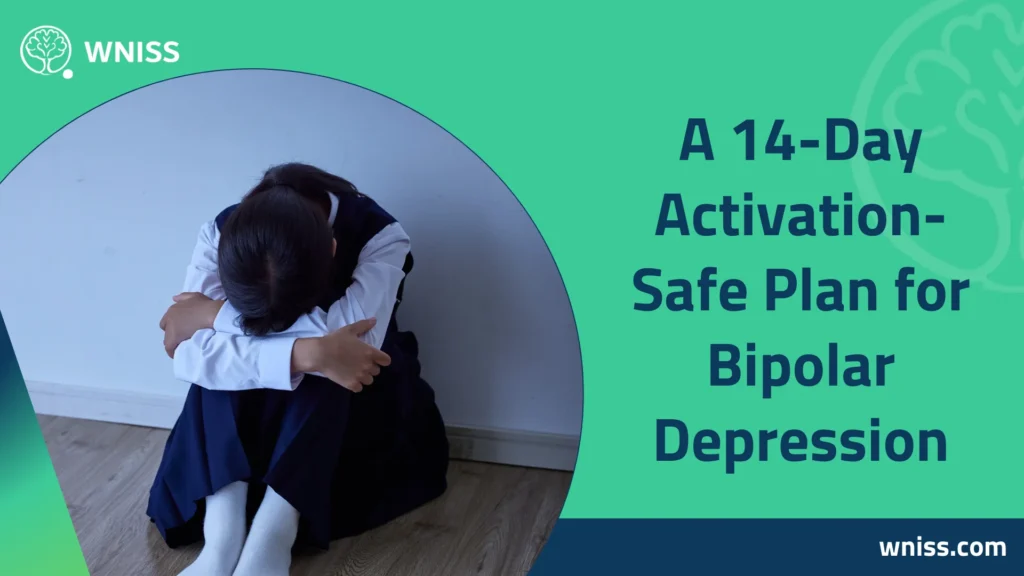
- Days 1–3 — Install anchors
- Pick a sleep window (e.g., 11:30–07:00) and hold it within ±30 minutes—even after bad nights
- Morning light 10–20 minutes + 5–10 minutes of movement (walk/stretch)
- Start a one-line nightly log and list 3 red flags (e.g., sleep <6 hours ×2 nights, racing ideas, spending surge)
- Days 4–7 — Reduce noise & rehearse wins
- Caffeine last call 8+ hours before bed; devices out of bed; set a wind-down (dim → hygiene → brief reading)
- Behavioral activation: 2 tiny tasks/day (5–20 min)—one self-care, one life admin
- Opposite action: when urge = avoid, do the easiest version for 5 minutes
- Days 8–10 — Add structure & support
- Block a daily “focus hour” after light/movement for the hardest task
- Schedule two low-stakes social contacts (text/walk/coffee)
- Hold a 15-minute partner/family check-in: appreciations → what helped → one small change; confirm what triggers escalation
- Days 11–14 — Stress-test & tune
- Simulate a late meeting or travel night; keep the same wake time next morning; add light + a short walk to reset
- Review your log with a clinician/coach; keep two habits, tweak one (earlier caffeine cut, firmer wind-down)
Partner & Family Playbook (make help… helpful)
.Support works best when it’s specific and rehearsed, warmth matters; scripts matter more when energy is low
- During lows: offer tiny tasks (“I’ll sit with you for the first 5 minutes”), protect sleep timing, and avoid problem-solving marathons at night
- If activation appears: keep voices calm, lower stimulation (lights/screens), reinforce the pause script for purchases/commitments
- Weekly: hold one repair/plan conversation (15–20 minutes) and update the early-warning/crisis ladder (steps 1–3, who to call)
Reclaim the Day—Start WNISS’s Bipolar Depression Plan (Online & Measured)
You don’t need another list—you need one coordinated plan that fits your life and shows results on your calendar. At WNISS, we turn best-practice care into small, repeatable moves that build momentum without risking hypomania.
Bullet cues:
- Fast online assessment maps your episode history, sleep, triggers, and goals—summarized in plain English
- CBT + IPSRT you’ll actually use: graded activation, thought tools, and rhythm anchors you can keep on tough weeks
- Medication coordination with your prescriber for activation-safe choices and smart dose timing
- Dashboards you can trust: 60-second nightly logs and weekly reviews—progress becomes visible, not vague
- Life-fit scaffolds: shift-work, parenting, study, or travel—we adapt anchors so gains survive busy seasons
Ready to feel movement again? Book a confidential session now at WNISS and start your 14-day plan with a specialist by your side.
FAQs about Bipolar Depression

How do bipolar people think?
There’s no single “bipolar thinking style.” Between episodes, people think like anyone else. During depression, thinking can feel slow, pessimistic, and self-critical; during hypomania/mania, thoughts may speed up and feel unusually creative or confident. track sleep, speed of ideas, and confidence/irritability—they’re better signals than stereotypes.
What age does bipolar start?
Many first episodes emerge in late adolescence or early adulthood, though onset varies. Earlier recognition improves outcomes. if you notice new sleep changes + speed + risk in teens/20s—especially with family history—seek assessment early.
What triggers bipolar depression?
Episodes often follow sleep loss, high stress, or circadian disruption; substances can worsen vulnerability. Protect timing (bed/wake, meals, light), keep caffeine earlier, and plan travel/shift-work sleep in writing.
How long does a bipolar depressive episode last?
Ranges from weeks to months without treatment; many improve much faster with integrated care. Combine medication + CBT/IPSRT + routine; track weekly changes to adjust quickly.
Can antidepressants treat bipolar depression?
Sometimes—and usually with a mood stabilizer to lower activation risk. If used, monitor for falling sleep need, racing ideas, or spending surges; report changes promptly.
How can I help someone with bipolar depression?
Aim for structure + kindness. Protect sleep timing; offer 5–15-minute co-tasks; keep the pause script for big decisions; encourage weekly check-ins with the care team.
Bipolar depression is manageable when you treat it as a system: activation-safe medication choices, CBT/IPSRT delivered consistently, family alignment, and small daily anchors that run even on hard days. Start with the 14-day plan, track one line each night, and keep tuning weekly. If you want a kind, coordinated roadmap that fits your life, WNISS can meet you online and help you turn good intentions into steady days—this month.
Medical References
- National Institute of Mental Health (NIMH). Bipolar Disorder — Symptoms & Treatment.
https://www.nimh.nih.gov/health/topics/bipolar-disorder - NICE Guideline CG185. Bipolar disorder: assessment and management (adults).
https://www.nice.org.uk/guidance/cg185

